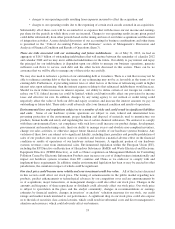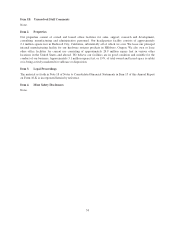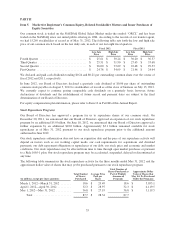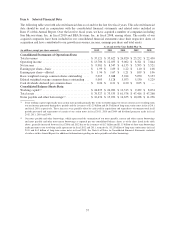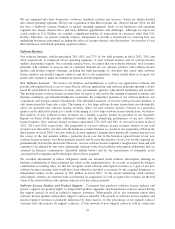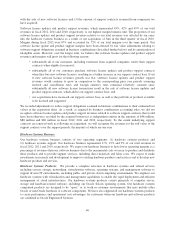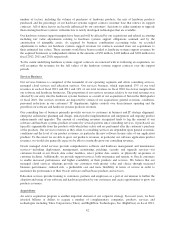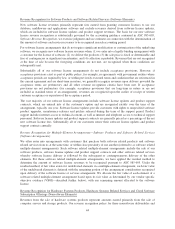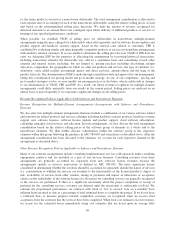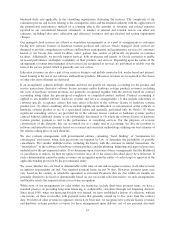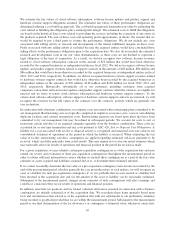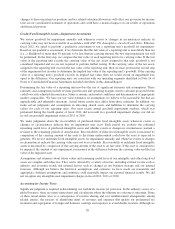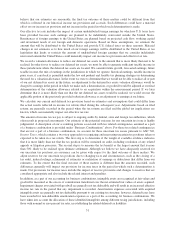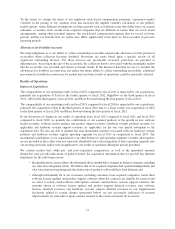Oracle 2012 Annual Report Download - page 47
Download and view the complete annual report
Please find page 47 of the 2012 Oracle annual report below. You can navigate through the pages in the report by either clicking on the pages listed below, or by using the keyword search tool below to find specific information within the annual report.and Art Technology Group, Inc. (ATG) and Phase Forward Incorporated (Phase Forward) in fiscal 2011, among
others. We believe our acquisition program strengthens our competitive position, enhances the products and
services that we can offer to customers, expands our customer base, provides greater scale to accelerate
innovation, grows our revenues and earnings and increases stockholder value. We expect to continue to acquire
companies, products, services and technologies in furtherance of our corporate strategy. Note 2 of Notes to
Consolidated Financial Statements included elsewhere in this Annual Report provides additional information
related to our recent acquisitions.
We believe we can fund our future acquisitions with our internally available cash, cash equivalents and
marketable securities, cash generated from operations, additional borrowings or from the issuance of additional
securities. We estimate the financial impact of any potential acquisition with regard to earnings, operating
margin, cash flow and return on invested capital targets before deciding to move forward with an acquisition.
Critical Accounting Policies and Estimates
Our consolidated financial statements are prepared in accordance with U.S. generally accepted accounting
principles (GAAP) as set forth in the Financial Accounting Standards Board’s (FASB) Accounting Standards
Codification (Codification) and consider the various staff accounting bulletins and other applicable guidance
issued by the SEC. GAAP, as set forth within the Codification, requires us to make certain estimates, judgments
and assumptions. We believe that the estimates, judgments and assumptions upon which we rely are reasonable
based upon information available to us at the time that these estimates, judgments and assumptions are made.
These estimates, judgments and assumptions can affect the reported amounts of assets and liabilities as of the
date of the financial statements as well as the reported amounts of revenues and expenses during the periods
presented. To the extent there are differences between these estimates, judgments or assumptions and actual
results, our financial statements will be affected. The accounting policies that reflect our more significant
estimates, judgments and assumptions and which we believe are the most critical to aid in fully understanding
and evaluating our reported financial results include the following:
• Revenue Recognition
• Business Combinations
• Goodwill and Intangible Assets—Impairment Assessments
• Accounting for Income Taxes
• Legal and Other Contingencies
• Stock-Based Compensation
• Allowances for Doubtful Accounts
In many cases, the accounting treatment of a particular transaction is specifically dictated by GAAP and does not
require management’s judgment in its application. There are also areas in which management’s judgment in
selecting among available alternatives would not produce a materially different result. Our senior management
has reviewed the below critical accounting policies and related disclosures with the Finance and Audit
Committee of the Board of Directors.
Revenue Recognition
Our sources of revenues include: (1) software, which includes new software license revenues earned from
granting licenses to use our software products and fees from cloud software subscription offerings, and software
license updates and product support revenues; (2) hardware systems, which includes the sale of hardware systems
products including computer servers and storage products, and hardware systems support revenues; and
(3) services, which includes software and hardware related services including consulting, managed cloud services
and education revenues. Revenue generally is recognized net of any taxes collected from customers and
subsequently remitted to governmental authorities.
43


